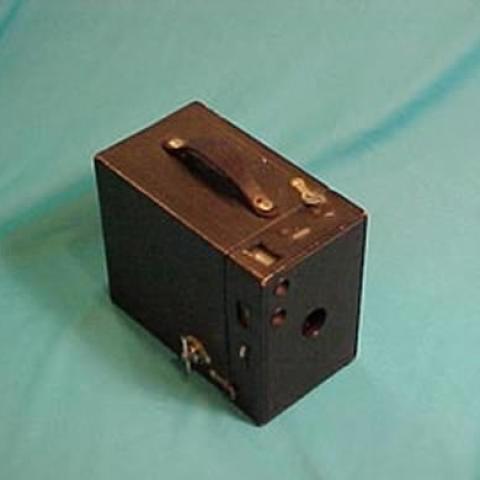
If you asked people in the 1950s, 1970s, or even 1990s what life would be like in the year 2000, a few probably would have had some pretty interesting answers for you. Futuristic clothing, spaceship-like cars, and advanced robotic systems to handle even the most ordinary daily tasks may have been among the responses. But now that we are well into the 21st century, we take a moment to reflect on an object that helped to usher in the beginning of a previous century.
The Kodak "Brownie" camera made its debut at the turn of the twentieth century and sold for one dollar. One hundred thousand of them were purchased during the first year alone. The Brownie helped to put photography into the hands of amateurs and allowed the middle class to take their own "snapshots" as well.
Eastman Kodak introduced the new Brownie dollar box camera in 1900; the release was supported by a major advertising campaign. The name "Brownie" was chosen primarily because of the popularity of a children's book of cartoons of the same name, and partly because the camera was initially manufactured for Eastman by Frank Brownell of Rochester, New York.
For years prior to Kodak's popularization of photography, the missing piece in its progress was the invention of a new artificial substance called celluloid. In 1873, John Wesley Hyatt invented and registered the name "celluloid." What he had invented was not exactly a new combination of chemicals, but rather a new way of molding the plastic and making it stay hard. For some years, Hyatt used celluloid only for making solid objects.
George Eastman, a bank clerk who was making $1500 a year in 1877, was so interested in photography that he went out and spent $94 on a photographic outfit. He saw that the new dry plates* would make possible a whole new market for photographic equipment. Within two years, Eastman had invented and patented a new machine for coating the glass plates. But he needed some flexible, light, and unbreakable substance that could be coated with the photographic substance. Celluloid became the answer to the problem. In 1884, he patented a way of coating strips of paper so that they would work in a camera, and from this point he initiated the popular revolution in photography.
To dramatize his innovative camera, Eastman decided to create a word that would be short, distinctive, and pronounceable in any language (he was envisioning a worldwide market). He began with "K," the first letter of his mother's maiden name, and finally came up with "Kodak." He registered the trademark and put his new camera on the market. Eastman had made everyone a photographer. His Kodak flourished on the slogan, "You press the button—we do the rest."
George Eastman continued to expand his business. In 1900, he purchased the Blair Camera Company of Boston, and the American Camera Company of Northboro, Massachusetts. At the same time the Brownie was introduced, E. &H.T. Anthony & Co. offered to sell out to Eastman, too. That offer was rejected, but Eastman accumulated a dry-plate manufacturing company in St. Louis, a card-mount business in Chicago, and control of the principal photographic outlets in Boston, Chicago, Minneapolis, St. Paul, Milwaukee, and Sioux City. Eastman Kodak soon became the dominant manufacturer of cameras and George Eastman was known as the "Kodak King."
Chemists had found a way to coat a glass plate with light-sensitive chemicals that would not lose their sensitivity when dry. The dry plates could be used in a camera without any special chemical preparation on the spot by the photographer. But the glass plates were still heavy, fragile, and hard to ship.
From the Kodak Brownie to the advanced cameras and equipment of today, all have significantly contributed to photography over the course of the century and will continue to be developed into the next millennium. Do you see any inventions or improvements that are poised and ready to take us into the future? What will people entering the year 2100 remember about the turn of this century?
Note: The object pictured above is part of The Franklin Institute's protected collection of objects. The images are ©The Franklin Institute. All rights are reserved.









